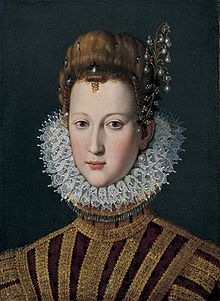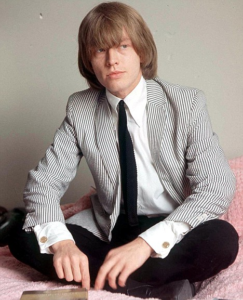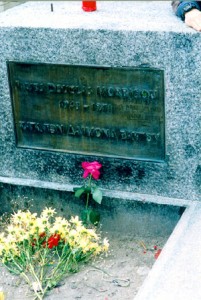 On this day in 1642, member of the wealthy and powerful House of Medici, Queen consort of France and Navarre, Marie de’ Medici died in Cologne at the age of 69. Born in Florence, Italy at the Palazzo Pitti on 26 April 1573, Marie was the sixth daughter of Francesco I de’ Medici, Grand Duke of Tuscany, and Joanna, Archduchess of Austria, daughter of Ferdinand I, Holy Roman Emperor, and Anna of Bohemia and Hungary. Marie was one of seven children, but only she and her sister Eleanora survived to adulthood. The House of Medici was a political dynasty, banking family and later royal house that first began to gather prominence under Cosimo de’ Medici in the Republic of Florence during the late 14th century. The family originated in the Mugello region of the Tuscan countryside, gradually rising until they were able to fund the Medici Bank. The bank was the largest in Europe during the 15th century and helped the Medici gain political power in Florence, though officially they remained citizens rather than monarchs. The Medici produced four Popes of the Catholic Church, Pope Leo X (1513–1521), Pope Clement VII (1523–1534), Pope Pius IV (1559–1565), and Pope Leo XI (1605); two regent queens of France, Catherine de’ Medici (1547–1559) and Marie (1600–1610); and, in 1531, the family became hereditary Dukes of Florence. In 1569, the duchy was elevated to a grand duchy after territorial expansion. They ruled the Grand Duchy of Tuscany from its inception until 1737, with the death of Gian Gastone de’ Medici. The grand duchy witnessed degrees of economic growth under the earlier grand dukes, but by the time of Cosimo III de’ Medici, Tuscany was fiscally bankrupt. Their wealth and influence initially derived from the textile trade guided by the guild of the Arte della Lana. Like other signore families they dominated their city’s government. The Medici were able to bring Florence under their family’s power, allowing for an environment where art and humanism could flourish. They fostered and inspired the birth of the Italian Renaissance along with other families of Italy, such as the Visconti and Sforza of Milan, the Este of Ferrara, and the Gonzaga of Mantua. The Medici Bank was one of the most prosperous and most respected institutions in Europe. There are some estimates that the Medici family were the wealthiest family in Europe for a period of time. From this base, they acquired political power initially in Florence and later in wider Italy and Europe. A notable contribution to the profession of accounting was the improvement of the general ledger system through the development of the double-entry bookkeeping system for tracking credits and debits. The Medici family were among the earliest businesses to use the system. Marie married Henry IV of France in October 1600 following the annulment of his marriage to Margaret of Valois. The wedding ceremony in Lyon, France was celebrated with 4,000 guests and lavish entertainments, including a production of the newly invented musical genre of opera, Jacopo Peri‘s Euridice. She brought as part of her dowry 600,000 crowns. Her eldest son, the future King Louis XIII, was born at Fontainebleau the following year. Following the assassination of her husband in 1610 she acted as regent for her son, King Louis XIII of France, until he came of age. She was noted for her ceaseless political intrigues at the French court and extensive artistic patronage.
On this day in 1642, member of the wealthy and powerful House of Medici, Queen consort of France and Navarre, Marie de’ Medici died in Cologne at the age of 69. Born in Florence, Italy at the Palazzo Pitti on 26 April 1573, Marie was the sixth daughter of Francesco I de’ Medici, Grand Duke of Tuscany, and Joanna, Archduchess of Austria, daughter of Ferdinand I, Holy Roman Emperor, and Anna of Bohemia and Hungary. Marie was one of seven children, but only she and her sister Eleanora survived to adulthood. The House of Medici was a political dynasty, banking family and later royal house that first began to gather prominence under Cosimo de’ Medici in the Republic of Florence during the late 14th century. The family originated in the Mugello region of the Tuscan countryside, gradually rising until they were able to fund the Medici Bank. The bank was the largest in Europe during the 15th century and helped the Medici gain political power in Florence, though officially they remained citizens rather than monarchs. The Medici produced four Popes of the Catholic Church, Pope Leo X (1513–1521), Pope Clement VII (1523–1534), Pope Pius IV (1559–1565), and Pope Leo XI (1605); two regent queens of France, Catherine de’ Medici (1547–1559) and Marie (1600–1610); and, in 1531, the family became hereditary Dukes of Florence. In 1569, the duchy was elevated to a grand duchy after territorial expansion. They ruled the Grand Duchy of Tuscany from its inception until 1737, with the death of Gian Gastone de’ Medici. The grand duchy witnessed degrees of economic growth under the earlier grand dukes, but by the time of Cosimo III de’ Medici, Tuscany was fiscally bankrupt. Their wealth and influence initially derived from the textile trade guided by the guild of the Arte della Lana. Like other signore families they dominated their city’s government. The Medici were able to bring Florence under their family’s power, allowing for an environment where art and humanism could flourish. They fostered and inspired the birth of the Italian Renaissance along with other families of Italy, such as the Visconti and Sforza of Milan, the Este of Ferrara, and the Gonzaga of Mantua. The Medici Bank was one of the most prosperous and most respected institutions in Europe. There are some estimates that the Medici family were the wealthiest family in Europe for a period of time. From this base, they acquired political power initially in Florence and later in wider Italy and Europe. A notable contribution to the profession of accounting was the improvement of the general ledger system through the development of the double-entry bookkeeping system for tracking credits and debits. The Medici family were among the earliest businesses to use the system. Marie married Henry IV of France in October 1600 following the annulment of his marriage to Margaret of Valois. The wedding ceremony in Lyon, France was celebrated with 4,000 guests and lavish entertainments, including a production of the newly invented musical genre of opera, Jacopo Peri‘s Euridice. She brought as part of her dowry 600,000 crowns. Her eldest son, the future King Louis XIII, was born at Fontainebleau the following year. Following the assassination of her husband in 1610 she acted as regent for her son, King Louis XIII of France, until he came of age. She was noted for her ceaseless political intrigues at the French court and extensive artistic patronage.
The Final Footprint – Marie was entombed in the Basilica of St. Denis. The Cathedral Basilica of Saint Denis is a large medieval abbey church in the city of Saint-Denis, now a northern suburb of Paris. The building is of unique importance historically and architecturally, as its choir completed in 1144 is considered to be the first Gothic church ever built. The abbey is where the kings of France and their families were buried for centuries and is therefore often referred to as the “royal necropolis of France”. All but three of the monarchs of France from the 10th century until 1789 have their remains here. Other notable final footprints at St. Denis include: Clovis I (465–511), Childebert I (496–558), Arégonde (c.515–c.573), Fredegonde (Wife of Chilperic I of Neustria) (?–597), Dagobert I (603–639), Clovis II (635–657), Charles Martel (686–741), Pippin the Younger (714–768) and his wife Bertrada of Laon (726–783), Carloman I King of the Franks (c.751–771), Charles the Bald (823–877) (his brass monument was melted down during the Revolution) and his wife, Ermentrude of Orléans (823–869), Carloman (866–884), Robert II the Pious (972–1031) and Constance of Arles (c. 986–1032), Henry I (1008–1060), Louis VI (1081–1137), Louis VII (1120–1180) and Constance of Castile (1141–1160), Philip II Augustus (1180–1223), Louis IX (1214-1270), Charles I of Naples (1226–1285), king of the Two Sicilies (1266–85). An effigy covers his heart burial, Philip III the Bold (1245–1285), Philip IV the Fair (1268–1314) and his mother Isabella of Aragon (1247–1271), Leo V of Armenia (1342–1393), Louis XII of France (1462–1515), Francis I (1494–1547), Henry II (1519–1559) and Catherine de’ Medici (1519–1589), Francis II (1544–1560), Charles IX (1550–1574) (no monument), Henry III (1551–1589), also King of Poland (heart burial monument), Henry IV (1553–1610), Louis XIII (1601–1643), Louis XIV (1638–1715), Louis XV (1710–1774), Louis XVI (1754–1793) and Marie Antoinette (1755–1793), Louis XVII (1785–1795) (only his heart; his body was dumped into a mass grave), and Louis XVIII (1755–1824).
 On this day in 1969, English musician, founding member of the Rolling Stones, and member of the Forever 27 Club, Brian Jones died in his swimming pool at Cotchford Farm at the age of 27. Born Lewis Brian Hopkins Jones on 28 February 1942 in Cheltenham, England. Although he was originally the leader of the group, Jones’s fellow band members Mick Jagger and Keith Richards soon overshadowed him, especially after they became a successful songwriting team. He developed a serious drug problem over the years and his role in the band steadily diminished. He was asked to leave the Rolling Stones in June 1969 and guitarist Mick Taylor took his place in the group. The coroner’s report stated “death by misadventure” and noted his liver and heart were heavily enlarged by drug and alcohol abuse. Club 27 or the Forever 27 Club; is a group of musicians or actors who died when they were 27 years old. The group includes; Robert Johnson, Jimi Hendrix, Janis Joplin, Jim Morrison (see below), Kurt Cobain, Amy Winehouse, and Anton Yelchin.
On this day in 1969, English musician, founding member of the Rolling Stones, and member of the Forever 27 Club, Brian Jones died in his swimming pool at Cotchford Farm at the age of 27. Born Lewis Brian Hopkins Jones on 28 February 1942 in Cheltenham, England. Although he was originally the leader of the group, Jones’s fellow band members Mick Jagger and Keith Richards soon overshadowed him, especially after they became a successful songwriting team. He developed a serious drug problem over the years and his role in the band steadily diminished. He was asked to leave the Rolling Stones in June 1969 and guitarist Mick Taylor took his place in the group. The coroner’s report stated “death by misadventure” and noted his liver and heart were heavily enlarged by drug and alcohol abuse. Club 27 or the Forever 27 Club; is a group of musicians or actors who died when they were 27 years old. The group includes; Robert Johnson, Jimi Hendrix, Janis Joplin, Jim Morrison (see below), Kurt Cobain, Amy Winehouse, and Anton Yelchin.

The Final Footprint – Jones was reportedly buried 12 feet deep in Cheltenham Cemetery (to prevent exhumation by trophy hunters) in a lavish casket sent by Bob Dylan.
 On this day in 1971, singer and lyricist for the rock band The Doors, poet, The Lizard King, Mr. Mojo Risin’, Jim Morrison died in his Paris apartment at the age of 27, thus becoming a member of Club 27 or the Forever 27 Club; a group of famous musicians or actors who died when they were 27 years old. The group includes; Robert Johnson, Brian Jones (see above), Jimi Hendrix, Janis Joplin, Kurt Cobain, Amy Winehouse, and Anton Yelchin. The cause of death was listed as heart failure though an autopsy was not performed as the medical examiner claimed to have found no evidence of foul play. Born James Douglas Morrison on 8 December 1943 in Melbourne, Florida. Probably one of the most iconic, charismatic and pioneering frontmen in rock music history. He remains popular and influential. Morrison graduated from UCLA. My favorite Doors songs inlcude; “Light My Fire”, “Love Me Two Times”, “Love Her Madly”, “Touch Me”, “People are Strange”, and “Break on Through”. Morrison’s long term companion/common-law wife was Pamela Courson. She died of a heroin overdose – at the age of 27.
On this day in 1971, singer and lyricist for the rock band The Doors, poet, The Lizard King, Mr. Mojo Risin’, Jim Morrison died in his Paris apartment at the age of 27, thus becoming a member of Club 27 or the Forever 27 Club; a group of famous musicians or actors who died when they were 27 years old. The group includes; Robert Johnson, Brian Jones (see above), Jimi Hendrix, Janis Joplin, Kurt Cobain, Amy Winehouse, and Anton Yelchin. The cause of death was listed as heart failure though an autopsy was not performed as the medical examiner claimed to have found no evidence of foul play. Born James Douglas Morrison on 8 December 1943 in Melbourne, Florida. Probably one of the most iconic, charismatic and pioneering frontmen in rock music history. He remains popular and influential. Morrison graduated from UCLA. My favorite Doors songs inlcude; “Light My Fire”, “Love Me Two Times”, “Love Her Madly”, “Touch Me”, “People are Strange”, and “Break on Through”. Morrison’s long term companion/common-law wife was Pamela Courson. She died of a heroin overdose – at the age of 27.
 The Final Footprint – Morrison is interred in the Père Lachaise Cemetery in Paris, one of the city’s most visited tourist attractions. His grave is marked by an upright granite marker with the Greek inscription; ΚΑΤΑ ΤΟΝ ΔΑΙΜΟΝΑ ΕΑΥΤΟΥ, literally meaning “according to his own daemon” and usually interpreted as “true to his own spirit”. Oliver Stone’s biopic The Doors, was released in 1991 and featured Val Kilmer as Morrison and Meg Ryan as Courson. Other notable Final Footprints at Père Lachaise include; Guillaume Apollinaire, Honoré de Balzac, Jean-Dominique Bauby, Georges Bizet, Maria Callas, Chopin, Colette, Auguste Comte, Jean-Baptiste-Camille Corot, Max Ernst, Molière, Édith Piaf, Camille Pissarro, Marcel Proust, Sully Prudhomme, Gioachino Rossini, Georges-Pierre Seurat, Simone Signoret, Gertrude Stein, Dorothea Tanning, Alice B. Toklas, Oscar Wilde, and Richard Wright.
The Final Footprint – Morrison is interred in the Père Lachaise Cemetery in Paris, one of the city’s most visited tourist attractions. His grave is marked by an upright granite marker with the Greek inscription; ΚΑΤΑ ΤΟΝ ΔΑΙΜΟΝΑ ΕΑΥΤΟΥ, literally meaning “according to his own daemon” and usually interpreted as “true to his own spirit”. Oliver Stone’s biopic The Doors, was released in 1991 and featured Val Kilmer as Morrison and Meg Ryan as Courson. Other notable Final Footprints at Père Lachaise include; Guillaume Apollinaire, Honoré de Balzac, Jean-Dominique Bauby, Georges Bizet, Maria Callas, Chopin, Colette, Auguste Comte, Jean-Baptiste-Camille Corot, Max Ernst, Molière, Édith Piaf, Camille Pissarro, Marcel Proust, Sully Prudhomme, Gioachino Rossini, Georges-Pierre Seurat, Simone Signoret, Gertrude Stein, Dorothea Tanning, Alice B. Toklas, Oscar Wilde, and Richard Wright.
#RIP #OTD in 1993 professional baseball pitcher, Brooklyn / Los Angeles Dodger, 9x All-Star, 3x World Series Champion, Hall of Famer, No. 53 retred, television sports commentator, Don Drysdale died; heart attack; Montréal aged 56. Cremation
#RIP #OTD in 2014 photographer best known for her images of rock and roll acts, Jini Dellaccio died at age 97 in Seattle, Washington
Have you planned yours yet?
Follow TFF on twitter @RIPTFF

